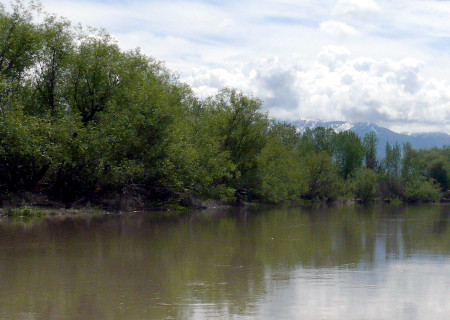
A floodplain is the low-lying ground adjacent to a river subject to flooding. A river terrace is the bench or step that extends along the side of a valley and represents a former level of the floodplain of a stream or river.
Rivers are dynamic systems. They can move laterally as a result of bank erosion and deposition, and vertically as a result of bed aggradation or degradation. Floodplains and terraces are usually formed through these processes. Therefore, floodplains and terraces are essentially part of the river system.
Related resources for County planning include the following:
Floods usually occur when the river channel reaches its maximum capacity and water starts overflowing streambanks and onto nearby areas that would otherwise be dry, when heavy rains or snowmelt deliver water at a rate faster than the soils can absorb it, or when a dam, landslide or other obstruction impounding water gives way rapidly releasing a large amount of water. For the most part, flooding is a natural process that supports channel maintenance, ecological processes, and riparian vegetation, and usually occurs during peak flows or periods of high water discharge.[1] Nevertheless, floods can cause severe human impacts and therefore need to be mitigated.
The Federal Emergency Management Agency (FEMA) provides flood data that classifies areas based on their different flood hazards through the National Flood Hazard Layer (NFHL) so that community officials, emergency responders, and the general public can be informed and plan accordingly to avoid or reduce impacts from floods guide development and reduce risk by excluding areas shown as flood hazard areas. All five counties of WFRC have been digitally mapped by NFHL.
Best management practices (BMPs) related to floodplains usually relates to preventing development within areas prone to flooding. Other BMPs to mitigate the impacts of floods usually resort to the development of plans for areas subject to flood hazards, and the protection and creation of buffers between waterbodies and the built environment. Counties in the Wasatch Front area agree on the need of a buffer area and avoidance of flood hazard areas where possible. In addition, counties like Morgan have also opted for adopting policies that discourage development in floodplain areas.
The NHFL data and the GSL Flooding data shows potential flooding areas. Counties can consider these areas in their planning efforts.
Major economic considerations for floodplains are higher development costs to mitigate flood risks. Costs include earthen fill to raise building footprints above flood elevations and other flood control structures on private lands. Flood control costs may also be passed onto municipal and county governments during flood emergencies.
A 2015 American Society of Civil Engineers’ report gave Utah’s levee systems a “D-” grade. The report noted that of the 21 miles of levees tracked by the US Army Corps of Engineers, 19.5 miles are considered unacceptable. Flooding in 2011 in Weber County was directly attributed to inadequate levees.[2]
Another economic consideration is the cost of floodplain insurance to homeowners. Development in areas subject to floods should meet additional flood proofing requirements. Laws and regulations regarding floodplain management usually vary between communities.
Floods are the leading cause of natural disaster deaths worldwide. Floods also have the potential to cause significant financial damage. In order to prevent catastrophes, engineers and scientists work constantly on methods to minimize the impacts of floods.
The probability of flooding at specific areas can be determined by using historical data and prediction models. Floodplains are usually classified based on the probability of a specific flood event happening in that area. For example, a 100-year floodplain means that a flood event that can inundate the specific area has a probability of happening once in 100 years. This does not mean that the area would be inundated once every 100 years; a 100-year floodplain can actually be inundated 2 years in a row. Rather, this means that every year there would be a 1% probability of a 100-year flood happening in that area.
Climate change and the potential to have an altered hydrologic regime in Utah increases uncertainty and risk. This one may be controversial, but most climate scientist agree that extreme events, either flood or drought, will become more common. Therefore what is considered a 100-year flood may occur more or less frequently in the future.
Floodplain Insurance Rate Maps (FIRM) are published by the Federal Emergency Management Agency and show the 100-year, 500-year, and flood-prone areas (if the area has been mapped). Some maps are quite old and possibly out-of-date.
| Data Name | Data Explanation | Publication Date | Spatial Accuracy | Contact |
|---|---|---|---|---|
| GSL Flooding and Shoreline | Great Salt Lake Floodplain Management Service Study (FPMS) | June 10, 1999 | 1:24,000 | AGRC |
| National Flood Hazard Layer (NFHL) | NFHL data incorporates all Flood Insurance Rate Map (FIRM) databases published by FEMA, and any Letters of Map Revision (LOMRs) that have been issued against those databases since their publication date | Davis: June 26, 2015 Morgan: August 26, 2015 Salt Lake: August 26, 2015 Tooele: November 18, 2009 Weber: August 26, 2015 | 1:12,000 | U.S. Federal Emergency Management Agency |
References
- Jordan River Commission. 2013. Best Practices for Riverfront Communities.
- American Society of Civil Engineers. 2015. Report Card for Utah’s Infrastructure.